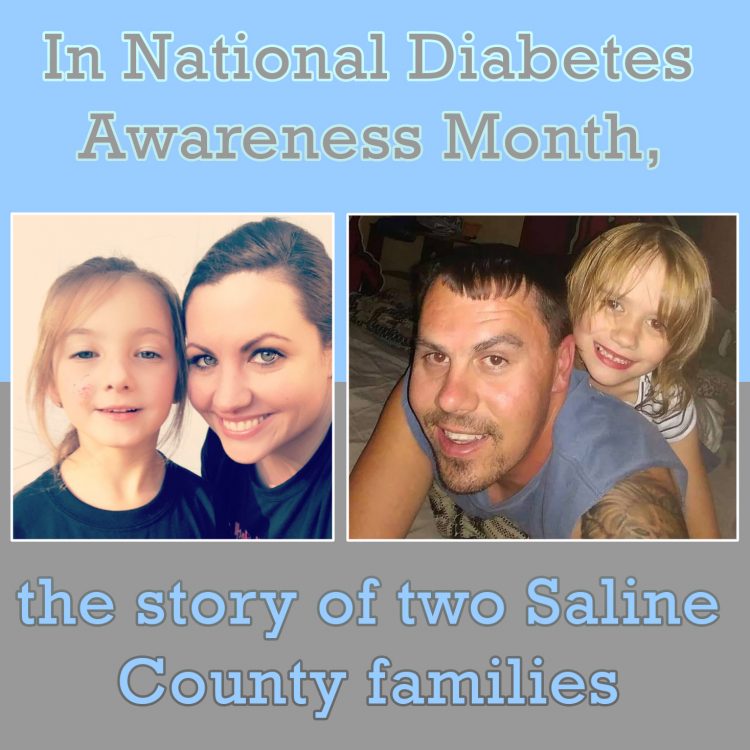November being Diabetes Awareness Month, I’m sharing a story of how the friendship of two little girls in Saline County ended up saving one’s life.
We know now that Kinsley Linebarger has Type 1 Diabetes. Angela Dove Linebarger took her then four-year-old daughter to the doctor in March 2018. She knew that Kinsley’s extraordinary thirst was an indicator of possible diabetes. Kinsley’s sugar blood test of 100 was rather normal, but the doctor ran a more comprehensive test. It is an A1C test which shows sugar levels over an extended period of time. A reading of over 6.5 indicates diabetes. Her daughter’s reading was 12.5.
Kinsley’s dad and grandfather were both diabetics, but Angela was still shocked that her precious child had it too. The girl was immediately sent to Arkansas Children’s Hospital where she and her mom remained for several days. Kinsley couldn’t be released until Angela completed care classes, tests and training.
Since Kinsley has no symptoms of highs and lows, she has to be monitored very closely. Angela had to do a finger stick every few hours around the clock to check the blood glucose level. After about a month of this, Kinsley was finally given a Dexcom continuous glucose monitor. It is a device that is stuck to the abdomen and has a tiny wire inserted beneath the skin. It communicates to a small handheld device that shows the glucose level. It alarms if her level goes under 70 or above 250. Six months was spent waking to the alerts, giving insulin because the level was too high, and then a couple of hours later, it would be too low.
“Let me tell you, it is not fun waking up a 5-year-old at 2 a.m. to try to get her to drink juice. I am a single mom who works 40 hours a week. I was like a zombie,” said Angela.
Fast forward to shortly before Halloween, Kinsley was able to get an Omnipod wireless insulin pump. Doctors say it’s the best for small children mostly because it is waterproof. Traditional pumps have tubing that need to be removed for bathing. Children can get the tubing tangled or pulled loose.
The package arrived with three months of insulin pods and handheld interface. The Pod is a small device that you fill with insulin and wear directly on your body. It includes a small, flexible cannula that inserts into the skin with the push of a button. It monitors glucose level and delivers insulin when needed by communicating wirelessly with the handheld Personal Diabetes Manager. Each pod lasts 72 hours. The invoice for this equipment was around $4,500. Angela is fortunate to work for a health insurance company in Little Rock and all of it was covered 100%.
Kinsley started to school at Bauxite in the fall of 2018 under a school choice status. Angela feared her daughter might not be accepted because of her illness, but the school allowed it. There are two school nurses who monitor what Kinsley eats for lunch and they calculate her insulin based on the doctor’s orders. There had been another girl with diabetes, Natalie Purifoy, who was in a certain teacher’s class the previous year, so Kinsley naturally fit in with that teacher who had knowledge of the condition. The two girls saw each other a lot in the nurse’s office and became friends. Natalie soon noticed that Kinsley had the Dexcom and wondered why she didn’t have one also. Her insurance with ArKids 1st did not cover the pods.
Natalie really needed the pods. Her father, Jimmy Purifoy, took the same care classes as Angela, but Natalie stays with her grandparents when Jimmy works out of town, and they are not trained as well.
There are some very noticeable differences in the two girls. Kinsley is now 5 and weighs 50 pounds. Natalie is almost 7 and weighs around 35 pounds. Clearly she was not thriving as well.
One day, the mom came in to talk to the nurses about the two girls. It was mentioned that Natalie didn’t understand why she didn’t have the things that Kinsley has. During this time, Natalie’s father came to check on her. The two parents talked about whether Jimmy’s insurance would cover this device. Angela texted the device provider and they told her that his insurance would not cover their device.
The nurse explained to the dad the desperate need for his daughter to have this pump for glucose control, and how much easier it will be for him and his parents. As any good father would, he said he will pay for it no matter what – until he found out the astronomical cost.
In talking more to the father, Angela found that he works for the same company as her brother, Jake Dove. Unknown to this dad she just met, she told Jake about this coincidental situation.
“I asked if he knew my brother and he mentioned he met him once, as they work on different sides of the company,” said Angela, “It felt like divine intervention. I looked at Jimmy and said I’m going to do something about this!”
Jake knew that employees have to be with the company for a year to qualify for insurance, but he went to Jimmy’s boss anyway. He asked if Jimmy – a new employee since September – was doing a good job. Then he asked if he felt Jimmy would stay a year. The boss said yes to both. Then the brother explained the situation and how dire it was for the child. Jimmy’s boss went to the owner with this information and he decided right then to put the man on company insurance.
Shortly afterward, Jimmy called Angela to tell her someone talked to his boss about putting him on insurance. Angela started to apologize for going behind him, but he just started thanking her profusely.
“I never thought someone I met an hour ago would do something like that,” said Jimmy.
Now that Angela knew he would have different insurance, she texted the device again rep to see if it would cover the pods. They said yes! The dad thanked her again profusely. What are the odds that all these coincidences would line up the way they did?
Angela said, “It warmed my heart to know that there are companies that care about their employees and their families and it made me proud that my brother works there and that they are right here in Saline County.”





